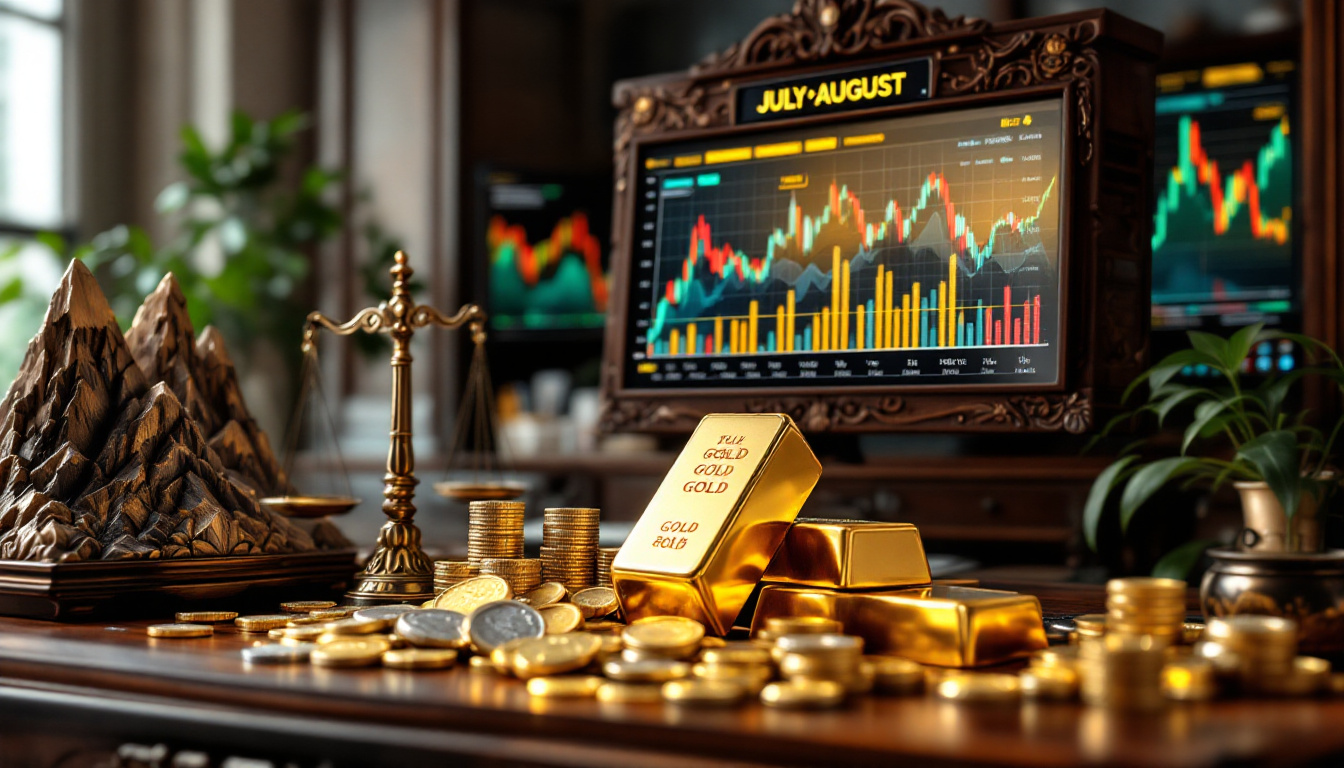What Are the Key Factors Driving Gold Prices Higher?
Gold has been on an impressive upward trajectory, reaching unprecedented price levels in recent times. This precious metal's remarkable performance is driven by multiple interconnected factors that continue to strengthen its position as a premier safe-haven asset and potential alternative to traditional reserve currencies.
According to Paul Wong, Sprott Market Strategist, "Gold's unique properties make it an ideal candidate for a neutral reserve asset… politically and monetarily neutral." This sentiment captures why the yellow metal continues to attract significant investment despite fluctuations in other asset classes.
Why Is Gold Reaching All-Time Highs?
Central Bank Purchasing at Record Levels
Central banks worldwide have significantly increased their gold reserves, acquiring over 1,000 tonnes annually for the past three years (2023-2025). This unprecedented buying spree reflects growing concerns about global economic stability and represents a strategic diversification away from traditional currency reserves.
China, Russia, and India have led recent gold acquisitions, signaling a strategic shift in how nations view long-term monetary security. These purchases have created consistent demand pressure that supports higher gold prices.
Deglobalization and Multipolar Economic Shifts
The global economy is experiencing a fundamental restructuring, characterized by:
- Rapid deglobalization trends disrupting established trade patterns
- Emergence of a multipolar economic landscape with uncertain outcomes
- Increasing trade tensions between major economies
- Implementation of extraordinary tariffs affecting international commerce
- Renegotiation of economic relationships between nations
These shifts create uncertainty that historically benefits gold as a safe-haven asset. Over 20 countries renegotiated bilateral trade agreements in 2024–2025, creating disruptions that sent investors seeking stability.
U.S. tariffs on EU steel (2024) and Chinese EVs (2025) have significantly disrupted global supply chains, further accelerating the move toward gold as a hedge against economic uncertainty.
Diminishing Trust in US Treasuries
US Treasury bonds, traditionally considered the safest investment class globally, are showing concerning volatility patterns:
- Treasury market volatility surged to 25% in 2025 (versus 10% 10-year average)
- Growing investor concerns about long-term stability
- Diminishing confidence in US fiscal management
- U.S. debt-to-GDP ratio surpassing 130% in 2025, eroding bond market confidence
Paul Wong notes that "U.S. Treasuries now behave like risk assets… questions about fiscal sustainability are growing." This erosion of trust in what was once considered the ultimate safe asset has created a significant opportunity for gold to capture market share.
How Is Gold Becoming a Reserve Currency Alternative?
Gold's Unique Neutral Asset Status
Gold possesses several characteristics that position it as an ideal neutral reserve asset:
- Political neutrality (not controlled by any single government)
- Monetary independence (immune to individual central bank policies)
- Historical recognition and acceptance across civilizations
- Substantial market size (~$12 trillion) with high liquidity
- Physical tangibility providing confidence during uncertainty
- Limited supply preventing artificial devaluation
These properties make gold exceptionally well-suited to function as a stabilizing element in a multi-asset reserve system. Gold's market size far exceeds alternatives like Bitcoin ($1.3T) and silver ($1.5T), making it uniquely positioned for large-scale reserves.
Multi-Asset Reserve System Development
As the world moves toward a more diversified reserve structure, gold is positioned to serve as:
- The "glue" connecting different reserve assets
- A valuation benchmark for other reserve components
- A politically neutral foundation for international settlements
- A stabilizing element during currency fluctuations
Gold now constitutes 15% of global reserves in 2025 (up from 10% in 2020), reflecting this transition toward a multi-asset reserve system. As Wong explains, "Gold's neutrality and liquidity make it the only viable glue for a multi-asset reserve system."
Real-world examples already support this trend. Iran and India used gold for oil transactions in 2024, bypassing traditional currency settlement systems and demonstrating gold's renewed utility in international trade.
What Political Factors Are Boosting Gold's Appeal?
Federal Reserve Independence Concerns
Threats to undermine the independence of the US Federal Reserve have emerged as a significant catalyst for gold price forecast appreciation:
- Public calls from political figures to lower interest rates
- Direct criticism of Federal Reserve leadership
- Potential erosion of institutional autonomy
- Market reactions demonstrating sensitivity to these concerns
The Fed credibility index fell to 65% in 2025 (down from 85% in 2020), indicating growing concerns about central bank independence. Trump's public criticism of Chair Powell in April 2025 triggered immediate market reactions, with gold gaining 3% in a single session.
Historical precedent supports gold's sensitivity to Fed independence concerns. Gold rose 30% in 2019 amid similar political pressure on the Federal Reserve, suggesting a pattern that investors recognize.
Credibility Challenges for Reserve Currencies
The foundation of sovereign currencies and bonds rests on:
- Rule of law
- Strong governance
- Independent institutions
Any erosion of these pillars could trigger:
- Bond market instability
- Significant currency devaluation
- Loss of international confidence
- Cascading financial risk events
Wong warns that "Eroding the Fed's autonomy risks a bond crisis… gold would soar in such a scenario." With real yields on 10-year Treasuries at -1.2% in 2025 (adjusted for inflation), the traditional advantage of holding bonds has diminished considerably.
Gold typically thrives in environments where traditional financial systems face credibility challenges, positioning it perfectly for the current economic climate.
What Are the Price Trends for Gold and Silver?
Gold's Recent Price Performance
Gold has demonstrated remarkable strength:
- Briefly touched gold all-time highs of US$3,500/oz in April 2025
- Currently trading around US$3,220/oz
- Showing resilience during market volatility
- Maintaining upward momentum despite occasional corrections
These price levels represent significant growth from historical averages and suggest continued momentum in the factors driving gold higher.
Silver Market Dynamics
Silver experienced more volatility than gold:
- Underwent a 4.3% correction in April 2025
- Shows increasing correlation with copper (reaching 0.7 in 2025 vs. 0.4 in 2020)
- Maintains its underlying monetary characteristics
- Expected to reassert its traditional relationship with gold
- Critical price level identified at $35/oz with potential for impulsive moves higher
The gold-silver ratio insights stand at 83:1 in 2025 (versus a 68:1 10-year average), suggesting silver may be undervalued relative to gold. As Wong notes, "Silver's monetary value will reassert itself… $35/oz is critical."
Silver's dual nature as both a monetary and industrial metal creates unique market dynamics, with growing industrial demand from solar PV and electronics manufacturing providing additional price support.
What Long-Term Structural Factors Support Higher Gold Prices?
Persistent Geopolitical Uncertainty
Ongoing global tensions create an environment favorable for gold:
- Regional conflicts affecting supply chains
- Resource nationalism limiting access to critical minerals
- Unpredictable policy changes affecting international trade
- Diplomatic realignments creating new economic blocs
These factors contribute to a persistent risk premium in gold pricing. The formation of new trade alliances and economic blocs has accelerated capital flows toward gold as a hedge against geopolitical instability.
Inflation and Currency Devaluation Concerns
Despite official narratives about controlled inflation:
- Real-world inflation experiences often exceed official metrics
- Currency purchasing power continues to decline in many regions
- Central bank balance sheet expansion creates monetary inflation concerns
- Debt-to-GDP ratios reaching historically high levels
Gold has traditionally served as a hedge against these monetary phenomena. Even with moderate headline inflation figures, purchasing power erosion in housing, healthcare, and education has driven investors toward gold's historical stability.
How Might Political Developments Impact Gold's Future?
Potential Central Bank Policy Interference
Any political interference with central bank operations could:
- Undermine market confidence in monetary policy
- Create unpredictable interest rate environments
- Trigger capital flight from affected currencies
- Accelerate diversification into alternative assets like gold
The market remains highly sensitive to signals of political pressure on monetary authorities. Analyzing gold's performance during past Fed politicization events (particularly the 1970s) reveals that central bank independence concerns typically coincide with gold bull markets.
Global Reserve Currency Status Questions
The US dollar's position as the world's primary reserve currency faces increasing scrutiny:
- Alternative payment systems developing internationally
- Bilateral currency agreements bypassing dollar settlement
- Strategic reserve diversification by multiple nations
- Growing questions about long-term dollar stability
These developments support structural demand for alternative reserve assets like gold. BRICS nations in particular have accelerated gold accumulation strategies, viewing the metal as a counterbalance to dollar dependence.
What ASX Gold Stocks Are Performing Well?
The Australian gold sector has seen varied performance, with standout companies including:
- Catalyst Metals (ASX:CYL) showing exceptional growth with a 724% annual increase
- Native Mineral Resources (ASX:NMR) delivering 742% annual returns linked to Western Australian discoveries
- Evolution Mining (ASX:EVN) demonstrating strong gold market performance with 105% annual growth
- Gold Road Resources (ASX:GOR) achieving 109% annual returns
- Northern Star Resources (ASX:NST) maintaining solid performance with 27% annual growth
These companies represent different segments of the gold mining sector, from major producers to exploration companies making significant discoveries. Their success underscores the broader strength in the factors driving gold higher.
FAQ: Understanding Gold's Current Market Position
Is gold's price increase sustainable or just a temporary bubble?
Multiple structural factors support gold's long-term value proposition, including central bank buying, geopolitical uncertainty, and diminishing confidence in traditional reserve assets. While price corrections are normal in any market, the fundamental 3000 price surge explained by experts suggests the underlying drivers appear to be strengthening rather than weakening.
With central banks purchasing over 1,000 tonnes annually and institutional investors increasing allocations, the demand side remains robust enough to support current price levels.
How does gold perform during periods of higher interest rates?
Historically, gold has faced headwinds during high real interest rate environments. However, the current market demonstrates that gold can perform well even with elevated nominal rates if real rates (adjusted for inflation) remain low or negative, or if other factors like geopolitical risk or currency concerns take precedence.
With real yields on 10-year Treasuries at -1.2% in 2025, the opportunity cost of holding gold remains low despite nominally higher interest rates.
What role does gold play in a modern investment portfolio?
Gold serves multiple functions in contemporary portfolios: inflation hedge, currency devaluation protection, geopolitical risk insurance, portfolio diversifier, and potential growth asset. Its low correlation with traditional financial assets makes it valuable for reducing overall portfolio volatility.
Professional portfolio managers typically recommend allocations between 5-15% depending on risk tolerance and economic outlook, with higher allocations during periods of heightened uncertainty.
How do central bank gold purchases affect market prices?
Central bank buying creates significant structural demand that can support price levels over extended periods. Unlike speculative investment, central bank acquisitions typically represent long-term strategic holdings that rarely return to the market, effectively reducing available supply.
The consistent purchasing of over 1,000 tonnes annually for three consecutive years has created a floor for gold prices that is unlikely to disappear in the near term.
Disclaimer: This article contains forward-looking statements and market analysis based on current trends. Financial markets are inherently unpredictable, and investors should conduct their own research before making investment decisions. Past performance is not indicative of future results.
Want to Discover the Next Major ASX Mineral Find?
Stay ahead of the market and receive instant alerts on significant ASX mineral discoveries, including gold and precious metals, with Discovery Alert's proprietary Discovery IQ model. Explore our dedicated discoveries page to understand how major mineral finds can generate substantial returns for investors.




